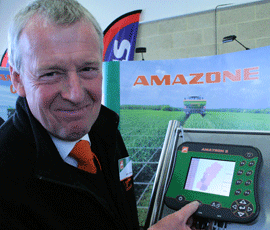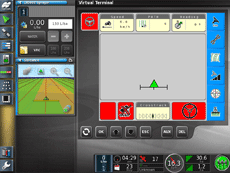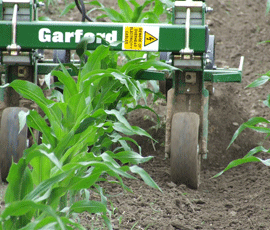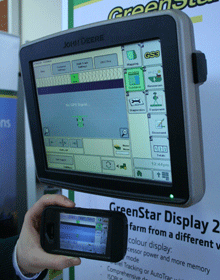Latest GPS kit from the Precision Farming Event

For farmers wanting to get up to speed on GPS advances, the Precision Farming Event at the Peterborough Showground was the place to be last week.
Farmers wanting to check the compatibility of isobus electronics and the availability of isobus-compliant implements should have access to an online database next year.
Manufacturers are currently uploading details of their systems and using online test facilities. They hope to open the database to dealers by the end of this year and to end-users sometime after.
Apart from creating a useful resource, the process is helping drive manufacturers to improve the compatibility of their products.
“No one will want to be at the bottom of the compatibility list when the database goes live,” says Blair Hardie, technology sales support specialist at Agco. “It’s an important issue for farmers who invest in isobus equipment; they don’t want to find the system they’ve bought has less functionality than a standard control box.”
The database being compiled by members of the Agricultural Industry Electronics Foundation (AEF) is intended to provide a worldwide shop window for isobus electronics and implements, as well as a technical resource for compatibility testing and software upgrades.
One difficulty is that this is fast-moving technology; new functions and features are being dreamt up all the time by manufacturers of both electronics and implements, as evident from the new releases announced by suppliers at the Precision Farming Event.
Amazone Amatron 3 terminal
Amazone’s Amatron 3 terminal (pictured above) incorporates the GPS-Switch headland on/off and section control function that previously required a separate unit.
“It’s a very versatile unit that automatically boots up in either can-bus or isobus mode, depending on what it’s connected to,” says Simon Brown of Amazone.
Priced at £1,535, the Amatron 3 provides GPS-Track parallel guidance for a one-off licence fee of £885 and GPS-Switch for £830. In both cases, operators get 50 hours’ free use before having to unlock the software with a licence code.
New functions are variable rate application and a virtual headland feature that allows a drill operator to import an existing field boundary and define a “dummy headland” for automatic on/off control.
“You would normally have to drill the headland first to establish the boundary, which means you’re then turning where you’ve drilled,” explains Simon Brown. “With the dummy headland function, the operator enters the headland width he wants and can then sow the bulk of the field, leaving the headland until last.”
The variable rate spreading feature can be programmed by quantity in kilograms or by units; with the latter the system calculates the rate required to match the VRA map once the fertiliser specification has been entered.
Topcon X30 screen
 A terminal with one of the largest touch-screen displays available – Topcon’s isobus-compliant X30 – has gained additional features with the latest software release.
A terminal with one of the largest touch-screen displays available – Topcon’s isobus-compliant X30 – has gained additional features with the latest software release.
Sprayer section control can now handle up to 30 boom sections instead of 10, Job Assist displays quick reference help windows, and X Link provides a variable rate application function capable of working with a number of implement controllers.
“Once installed by one of our staff or a dealer, accessing the variable rate function requires a code and one-off £500 licence fee,” explains Nathan Watkins of Topcon distributor LH Agro. “It can then be used with implement controllers using the same protocol as the LH5000 – so that means units from Amazone, Arag, Bogballe, Flexi-coil, Hardi, Kverneland, Raven and Väderstad.”
Topcon also has a new satellite signal receiver with built-in software enabling it to show a guidance display on any isobus-compliant terminal – albeit a much more basic one than comes up on the X30 or other Topcon terminals. The AGI-4 also has a more powerful radio receiver for greater RTK compatibility.
RDS grain moisture sensor
Easier installation and access for cleaning is promised by a new grain moisture sensor developed by RDS Technology for its Ceres Yield Monitor and Combine Moisture Meter 100.
“It can either be installed on the bubble auger in the tank or on the inspection cover at the bottom of a clean grain elevator,” says Peter Nelson of RDS. “It’s easy to access for cleaning if need be, although we found test units stayed very clean last harvest, and it’s easily removed if you want to keep the moisture meter when the combine is sold.”
Unlike the complex sampling systems used on some combines, the RDS unit takes continuous readings as the grain flows over it, which Mr Nelson believes produces more consistent results.
Garford Robocrop weeder
 A refined “Mk 2” version of the Robocrop in-row weeder from Garford Farm Machinery has a new chassis that makes it suitable for front and rear mounting, gives easier access for adjusting the weeding units and affords the operator a clearer view of the mechanism.
A refined “Mk 2” version of the Robocrop in-row weeder from Garford Farm Machinery has a new chassis that makes it suitable for front and rear mounting, gives easier access for adjusting the weeding units and affords the operator a clearer view of the mechanism.
“Hundreds of Robocrop weeders are now working around the world, taking out weeds both between and within the rows of a variety of crops,” says Chris Lunn of Garford Farm Machinery. “The Mk 2 incorporates the latest software for increased work rate and better feedback to the operator.”
Production models cover 1.5-6m working widths and up to 18 rows, although larger units are available to special order.
Deere telematics
 Farmers subscribing to John Deere’s JDLink Ultimate telematics system can not only monitor their tractors and combines remotely, but can also see an operator’s view of the GreenStar terminal display in the cab.
Farmers subscribing to John Deere’s JDLink Ultimate telematics system can not only monitor their tractors and combines remotely, but can also see an operator’s view of the GreenStar terminal display in the cab.
Remote Display Access will be available for the top-spec isobus-compliant GreenStar 2630 terminal later this year. It allows a vehicle owner or authorised dealer staff to view the in-cab display via the internet on a desktop computer, laptop, tablet or smartphone.
“I expect people will use RDA to train operators or help inexperienced operators set up or adjust an implement through the isobus display,” says Robert Hill of John Deere. “You can’t make adjustments remotely, but you can talk through instructions with an operator while viewing the display.”
JDLink Select provides basic information, such as when the vehicle is switched on and off, and can be used to set curfew and geo-fence alarms for security. Ultimate transmits all data collected by the vehicle’s can-bus electronics to a secure website for management analysis. Both versions are currently free for the first 12 months.

